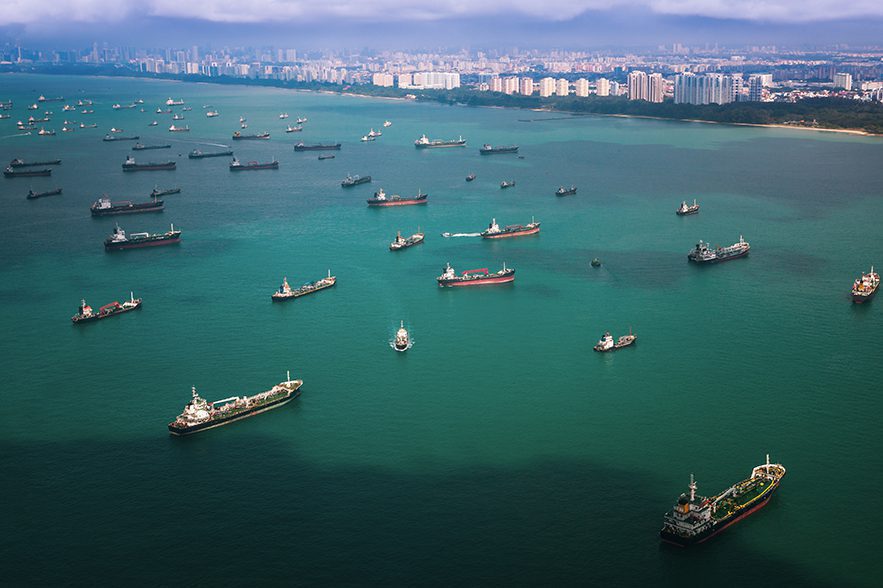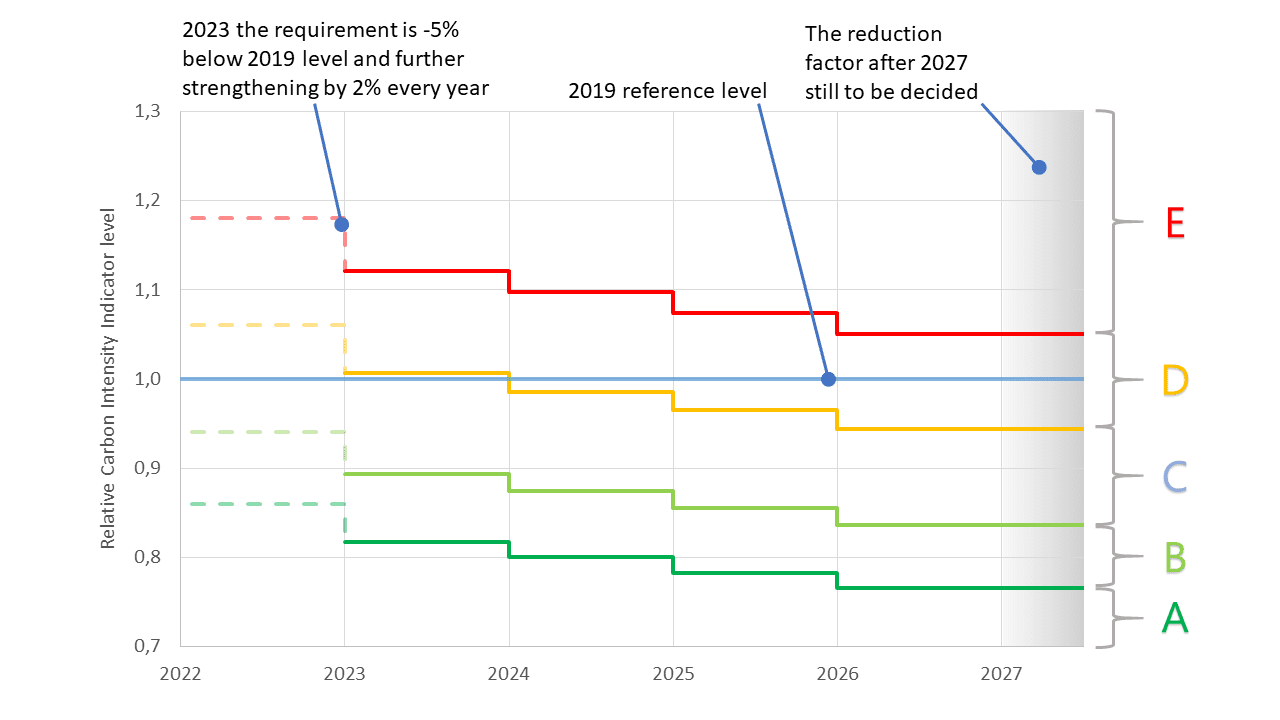October 19, 2021
How to navigate CII: what it is and how you can stay compliant
by Ossi Mettälä, Customer Success Manager, NAPA Shipping Solutions
In 2018, the International Maritime Organization (IMO) established its greenhouse gas (GHG) strategy in response to mounting pressure for climate action following the Paris Agreement. In the IMO’s initial strategy, the most crucial level of ambition is related to the carbon intensity of ships, which must decline. This reduction will be made possible through various energy efficiency and emissions reduction requirements that become stricter over time.
The second level of ambition is for the carbon intensity for international shipping to decline through a 40% reduction by 2030, and a 70% reduction by 2050 compared to the baseline value from 2008. This is such an ambitious target that it puts the situation into stark terms: if we want to achieve these goals and build a sustainable future, everyone must work together to innovate new solutions that conform to an increasingly tight set of criteria.

At the IMO’s 76th Marine Environment Protection Committee (MEP76) in July 2021, members agreed to put two new measures into effect at the start of 2023 – the energy efficiency index for existing ships (EEXI) and the carbon intensity indicator (CII). Where EEXI is concerned with how ships are equipped or designed, CII is an indicator of how the ships operate.
Imagine buying the most energy-efficient gasoline car in the world. Sure, you would be ticking the EEXI compliance box. But suppose you drive that car extremely inefficiently, braking and accelerating a lot, leaving gear shifts until the last minute, speeding, the engine idling when parked and letting the tires deflate. That same “energy-efficient” car would end up with a poor CII rating because of how you used it.
CII is an operational index based on another measure, the Annual Efficiency Ratio (AER), which measures all the carbon emissions from all ballast and laden voyages, anchorage, port stays, all divided by the deadweight and distance sailed in a year (grams of CO2 per DWT mile).

What does CII mean for shipowners?
Since 2019, it has been mandatory for ships to fulfill the IMO’s data gathering requirements (IMO Data Collection System, IMO DCS) by recording their fuel consumption, the distance they have traveled, and hours underway – all of which is needed to calculate the AER. And now that the IMO has that data, it has a good current picture of the industry.
Based on these AER results, ships will be grouped into different CII ratings, ranging from A to E. The most environmentally friendly will receive an A rating, while the highest polluters will be rated E.
The initial rating thresholds are set using 2019 as a base and will become stricter over time. By 2023, the reduction factor will be set at 5%. With the increasingly tight criteria, this might mean, in practice, for example, that if your ship receives a rating of B and no actions are taken for two years, then your ship could receive a rating of C the following year.

From 2023 onwards, if a ship is rated D or E, the owner of that ship will be seen as not doing enough to comply, and therefore not doing enough to fight climate change. The only direct impact is that those shipowners will need to update their Ship Energy Efficiency Management Plan (SEEMP) with how to improve their rating.
The pressure, however, lies within the IMO’s encouragement for all shipping stakeholders, such as charterers, ports, insurance companies, financial institutions and pilotage, to provide incentives for ships rated A or B. Even before CII, stakeholder consortiums started to steer towards greener shipping by giving incentives to greener ship operations (i.e. via the Sea Cargo Charter and Poseidon Principles). This leaves shipowners with higher emissions in a tough situation – with being “discriminated against” by potential customers (Sea Cargo Charter), not receiving funding (Poseidon Principles), and even more costly consequences that are likely to appear through other stakeholders.
So, how can you stay compliant with CII?
The bottom line of all of this is that any action that reduces emissions per distance the ship sails in a year improves your ship’s rating, which can take the form of either technical or operational improvements.
Since EEXI regulation demands technical improvements from shipowners, being more EEXI compliant, in general, also works towards better CII, and we focused on a list of actions you can take to comply with EEXI in an earlier blog post.
On the operational side, there are several concrete actions you can take that have a relatively high likelihood of reducing emissions. These actions can be taken immediately with existing solutions readily available and at a low cost. Operational improvements, for example, include weather routing, avoiding the rush-to-wait phenomenon, and timely ship maintenance and hull cleaning.
Monitoring ship performance, ship consumption trends and applying timely maintenance and hull cleaning is one way to keep CII in check. However, this is not just as simple as looking at fuel consumption reports day to day. Consumption will rise and fall depending on your ship’s speed, draft, and weather conditions. By correcting for those factors, you can get true insight into how to improve your CII. NAPA Fleet Intelligence has real, easy-to-use tools for monitoring your ship’s technical performance.
If your ship is not yet using a weather-routing solution, the time to adopt one is now. Our studies have shown that this type of solution leads to significant fuel savings. For example, our retro-optimization study of tanker voyages crossing the Atlantic revealed a fuel-saving (and therefore emissions saving) potential of 15.9%. In this study, time spent in heavy weather (BF4 and above) could have been reduced by 9.8%, and the original schedules were kept. In other words: in addition to the significant emissions savings, weather routing also increases safety and profit level.
Ships spend 10% of their life waiting in anchor; arriving just-in-time could reduce emissions by 20%.
The rush-to-wait phenomenon – the tendency for ships to sail fast at first and then wait at port queueing for their turn – will, hopefully, decrease with the implementation of CII. There is an opportunity for ships to sail more slowly, which is more energy-efficient, and arrive just in time to get to berth. This “just-in-time” arrival could save 20% of emissions. In practice, however, it has been quite complicated to reach a standardized system for just-in-time arrival that applies globally.
Regardless, most of this benefit could be achieved by optimizing arrival times in queues instead of trying to solve for the entire journey to berth. So, lowering the ambition level from just-in-time arrival to controlling the frequency of ships arriving to anchorage could still be enough to reach considerable emissions savings.
Why is CII so significant?
EEXI alone is not going to have a significant effect on the industry and, therefore, the environment. At NAPA, we have estimated that the global impact of EEXI on carbon intensity is -5.9%.
CII, on the other hand, has the potential to have a much bigger impact on the environment because it includes CO2 emissions holistically. CII looks at all of the emissions from a ship, so that includes things like idling time. A vessel will always produce some GHG emissions even when in anchorage or port, for example, through auxiliary engines. And while this might not seem like much compared to voyage movement, these small segments of emissions add up.
CII is a simple indicator and therefore has the potential to be powerful.
Our recommendations
Getting a good CII rating is going to be important from now on. At NAPA, we recommend tackling inefficiencies to help improve your CII, for example, by monitoring ship technical performance or with weather routing.
The safest and most efficient way to operate between two ports is by using the dynamic data available to you, not relying on personal experience alone. And with up-to-date vessel performance models, weather information, and nautical charts, data in NAPA Voyage Optimization is not static – everything is dynamic.
Historically, it has not been uncommon for ship owners to invest heavily in projects designed to improve fuel consumption by 3-5% overall. With voyage optimization, however, payback time is essentially immediate and the fuel-saving potential is significantly higher.
In the end, this comes down to staying aware of inefficiencies and addressing them to maximize your CII. That’s what we do at NAPA – we help you make the best decisions you can.
This blog post was originally published on LinkedIn on October 18, 2021.